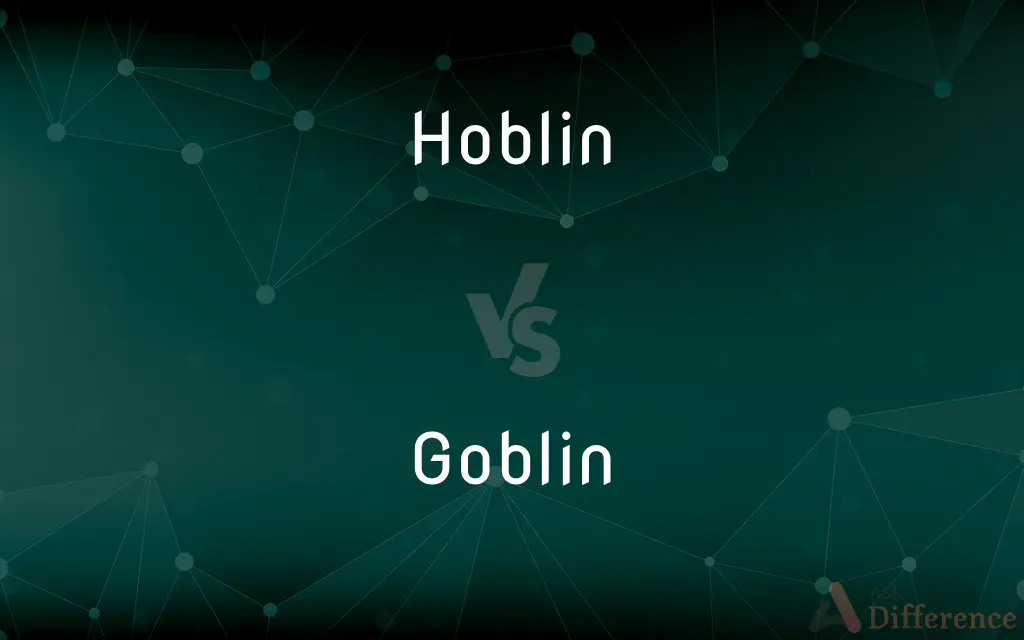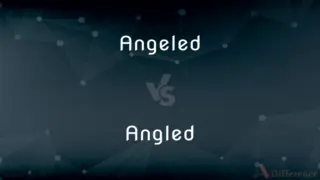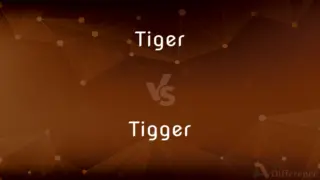Hoblin vs. Goblin — What's the Difference?
By Maham Liaqat & Urooj Arif — Updated on March 16, 2024
Hoblins are less common in folklore, often depicted as mischievous but not inherently evil, while goblins are widely recognized mythical creatures, typically characterized as malevolent or troublesome.

Difference Between Hoblin and Goblin
Table of Contents
ADVERTISEMENT
Key Differences
Hoblins, a term less frequently encountered in mythology and fantasy literature, often refers to creatures that are somewhat similar to goblins but may possess distinct traits or behaviors, such as a specific kind of mischief or a unique habitat. Whereas goblins are well-established in folklore across various cultures, generally portrayed as small, malicious beings with a penchant for causing trouble, hoarding treasures, or engaging in malevolent deeds.
The origins of hobgoblins and goblins diverge in folklore. Hobgoblins are sometimes depicted as household spirits, inclined towards playing pranks or offering help, albeit in a grudging or tricky manner. On the other hand, goblins have a broader representation, often found in wild places, ruins, or abandoned mines, and are feared for their trickery, theft, and sometimes even aggression towards humans.
Physical descriptions of hobgoblins and goblins can vary widely, but hobgoblins are occasionally portrayed as less grotesque and may even have a more human-like appearance, suggesting a somewhat benign nature. Goblins, however, are frequently described as small, grotesque, and repulsive creatures, with features that evoke their mischievous and malevolent character.
In some stories and interpretations, hobgoblins are considered a subcategory or relative of goblins, distinguished by their lesser inclination towards outright evil and a greater tendency towards mischief or benign interference in human affairs. Goblins, by contrast, are often depicted as inherently malevolent, with a disposition towards causing harm, stealing, and creating chaos.
The roles of hobgoblins and goblins in folklore and modern fantasy literature also differ. Hobgoblins might be seen as ambiguous figures, capable of both good and ill, often leaving humans to wonder about their true intentions. Goblins, however, are typically cast as antagonists or obstacles, embodying the darker aspects of the mythological creatures' spectrum, and serve as common foes in tales and fantasy games.
ADVERTISEMENT
Comparison Chart
Frequency in Folklore
Less common, specific traits.
Widely recognized, diverse portrayals.
Nature
Mischievous, not inherently evil.
Typically malevolent or troublesome.
Habitat
Often household spirits, hidden.
Wild places, ruins, often underground.
Appearance
Sometimes more human-like.
Small, grotesque, repulsive features.
Role in Stories
Ambiguous, can be benign or tricky.
Antagonistic, embody darker aspects.
Compare with Definitions
Hoblin
A less common mythical creature, often involved in mischief rather than evil.
The hoblin played tricks on the villagers but never caused serious harm.
Goblin
Commonly found in wild or abandoned places.
The ancient ruins were said to be infested with goblins after dark.
Hoblin
Often associated with households or specific localities.
The village hoblin was said to live near the old mill, watching over the area.
Goblin
Typically depicted as small, grotesque, and repulsive.
With its green skin and sharp teeth, the goblin was a frightful sight.
Hoblin
Known for pranks or ambiguous interactions with humans.
The hoblin secretly helped the farmer in exchange for small gifts.
Goblin
A widely recognized creature in folklore, often malicious.
The goblins stole from the travelers, hiding their loot in the deep forest.
Hoblin
May appear more human-like or less grotesque than goblins.
The hoblin had a mischievous smile and wore simple, earth-toned clothes.
Goblin
Associated with malevolence, trickery, and greed.
Goblins were known to lay traps for the unwary in their domain.
Hoblin
Serves as a figure of local lore, embodying the spirit of mischief.
Tales of the hoblin were passed down in the family as cautionary yet fond stories.
Goblin
Often the antagonist, causing trouble or fear.
In the tale, heroes ventured into the goblin's lair to retrieve the stolen treasure.
Hoblin
A goblin or hobgoblin-like creature.
Goblin
A goblin is a monstrous creature that appears in the folklore of multiple European cultures, first attested in stories from the Middle Ages. They are ascribed various and conflicting abilities, temperaments and appearances depending on the story and country of origin.
Goblin
A grotesque elfin creature of folklore, thought to work mischief or evil.
Goblin
One of various hostile supernatural creatures, now especially (fantasy literature) a malevolent and grotesque diminutive humanoid, often associated with orcs or trolls.
Goblin
An evil or mischievous spirit; a playful or malicious elf; a frightful phantom; a gnome.
To whom the goblin, full of wrath, replied.
Goblin
(folklore) a small grotesque supernatural creature that makes trouble for human beings
Common Curiosities
What distinguishes a hoblin from a goblin?
Hoblins are typically portrayed as mischievous but not inherently evil, possibly aiding humans, while goblins are seen as malevolent and troublesome.
Why are goblins often depicted as evil?
Goblins embody the darker aspects of folklore, representing fears and warnings about the dangers of greed, deceit, and the unknown.
Do hobgoblins and goblins appear in modern fantasy literature and games?
Both creatures are popular in fantasy, with goblins often serving as common foes and hobgoblins appearing in more nuanced roles.
Are there different types of goblins?
Yes, various cultures and stories depict different kinds of goblins, each with unique traits and behaviors.
Do hobgoblins live alone or in communities?
This varies by story, but hobgoblins can be solitary or part of a community, often linked to a specific location.
Are hobgoblins and goblins considered the same in all stories?
While sometimes used interchangeably, hobgoblins and goblins can have distinct roles, with the former being less evil and more inclined towards mischief.
Can hobgoblins be helpful to humans?
Yes, hobgoblins are sometimes depicted as offering assistance or protection, albeit in exchange for respect or offerings.
How can one protect themselves from goblins, according to folklore?
Folklore suggests using charms, wards, or simply avoiding places known to be inhabited by goblins to protect oneself.
What kind of treasures do goblins hoard?
Goblins are reputed to hoard gold, jewels, and magical items, often stolen from humans or acquired through deceit.
Are hobgoblins and goblins always portrayed negatively?
While goblins are typically negative figures, hobgoblins have a more nuanced portrayal, sometimes even positive.
Can goblins and hobgoblins change their nature?
Folklore and fantasy stories sometimes explore the idea that these creatures can change, especially in response to human actions or magical influences.
What do goblins fear?
In some tales, goblins fear light, loud noises, or specific magical items that can drive them away or harm them.
How do goblins communicate?
Goblins are often said to have their own language, though they may understand human languages to trick or deceive humans.
Do hobgoblins have a king or leader?
Some stories mention a king or chief among hobgoblins or goblins, ruling over them or leading their actions.
Share Your Discovery

Previous Comparison
Angeled vs. Angled
Next Comparison
Tiger vs. TiggerAuthor Spotlight
Written by
Maham LiaqatCo-written by
Urooj ArifUrooj is a skilled content writer at Ask Difference, known for her exceptional ability to simplify complex topics into engaging and informative content. With a passion for research and a flair for clear, concise writing, she consistently delivers articles that resonate with our diverse audience.














































